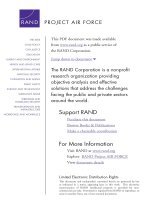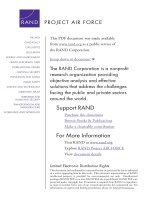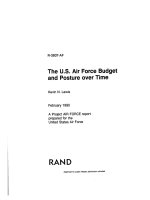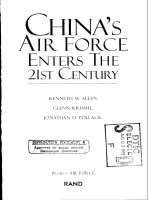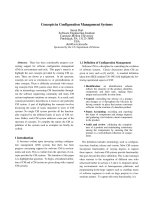Sustaining Air Force Space Systems ppt
Bạn đang xem bản rút gọn của tài liệu. Xem và tải ngay bản đầy đủ của tài liệu tại đây (761.77 KB, 67 trang )
This document and trademark(s) contained herein are protected by law
as indicated in a notice appearing later in this work. This electronic
representation of RAND intellectual property is provided for non-
commercial use only. Permission is required from RAND to reproduce, or
reuse in another form, any of our research documents.
Limited Electronic Distribution Rights
Visit RAND at www.rand.org
Explore RAND Project AIR FORCE
View document details
For More Information
This PDF document was made available
from www.rand.org as a public service of
the RAND Corporation.
6
Jump down to document
THE ARTS
CHILD POLICY
CIVIL JUSTICE
EDUCATION
ENERGY AND ENVIRONMENT
HEALTH AND HEALTH CARE
INTERNATIONAL AFFAIRS
NATIONAL SECURITY
POPULATION AND AGING
PUBLIC SAFETY
SCIENCE AND TECHNOLOGY
SUBSTANCE ABUSE
TERRORISM AND
HOMELAND SECURITY
TRANSPORTATION AND
INFRASTRUCTURE
WORKFORCE AND WORKPLACE
The RAND Corporation is a nonprofit
research organization providing
objective analysis and effective
solutions that address the challenges
facing the public and private sectors
around the world.
Purchase this document
Browse Books & Publications
Make a charitable contribution
Support RAND
This product is part of the RAND Corporation monograph series.
RAND monographs present major research findings that address the
challenges facing the public and private sectors. All RAND mono-
graphs undergo rigorous peer review to ensure high standards for
research quality and objectivity.
Prepared for the United States Air Force
Approved for public release, distribution unlimited
Don Snyder
•
Patrick Mills
•
Katherine Comanor
•
Charles Robert Roll, Jr.
Sustaining Air Force
Space Systems
A Model for the Global Positioning System
The RAND Corporation is a nonprofit research organization providing
objective analysis and effective solutions that address the challenges
facing the public and private sectors around the world. RAND’s
publications do not necessarily reflect the opinions of its research clients
and sponsors.
R
®
is a registered trademark.
© Copyright 2007 RAND Corporation
All rights reserved. No part of this book may be reproduced in any
form by any electronic or mechanical means (including photocopying,
recording, or information storage and retrieval) without permission in
writing from RAND.
Published 2007 by the RAND Corporation
1776 Main Street, P.O. Box 2138, Santa Monica, CA 90407-2138
1200 South Hayes Street, Arlington, VA 22202-5050
4570 Fifth Avenue, Suite 600, Pittsburgh, PA 15213-2665
RAND URL: />To order RAND documents or to obtain additional information, contact
Distribution Services: Telephone: (310) 451-7002;
Fax: (310) 451-6915; Email:
Library of Congress Cataloging-in-Publication Data
Sustaining Air Force space systems : a model for the Global Positioning System /
Don Snyder [et al.].
p. cm.
Includes bibliographical references.
ISBN 978-0-8330-4044-2 (pbk. : alk. paper)
1. Astronautics, Military—United States—Equipment and supplies. 2. Global
Positioning System. 3. United States. Air Force—Procurement. 4. United States. Air
Force Space Command—Planning. I. Snyder, Don, 1962– II. Rand Corporation.
UG1523.S87 2007
358'.88—dc22
2007001853
The research described in this report was sponsored by the United States
Air Force under Contract F49642-01-C-0003 and FA7014-06-C-0001.
Further information may be obtained from the Strategic Planning
Division, Directorate of Plans, Hq USAF.
Preface
Air Force Space Command (AFSPC) needs quantitative tools to assist
it in making decisions on how changes in the dollars invested in main-
tenance and sustainment of the ground segment of space systems affect
the operational performance of those systems. is monograph outlines
criteria for analyzing how sustainment investments affect the opera-
tional performance of space systems, focusing on the Global Position-
ing System. We offer a framework for such analyses and recommend
steps to implement that framework.
e research reported here was sponsored by Air Force Space
Command. e work was conducted within the Resource Manage-
ment Program of RAND Project AIR FORCE as part of a project
begun in late fiscal year 2005, “Air Force Space Command Logistics
Review.” A related document is
Space Command Sustainment Review: Improving the Balance
Between Current and Future Capabilities, Robert S. Tripp, Kristin
F. Lynch, Shawn Harrison, John G. Drew, and Charles Robert
Roll, Jr. (MG-518-AF, forthcoming).
e research for this report was completed in February 2006.
RAND Project AIR FORCE
RAND Project AIR FORCE (PAF), a division of the RAND Corpo-
ration, is the U.S. Air Force’s federally funded research and develop-
•
iii
ment center for studies and analyses. PAF provides the Air Force with
independent analyses of policy alternatives affecting the development,
employment, combat readiness, and support of current and future aero-
space forces. Research is conducted in four programs: Aerospace Force
Development; Manpower, Personnel, and Training; Resource Manage-
ment; and Strategy and Doctrine.
Additional information about PAF is available on our Web site at
/>iv Sustaining Air Force Space Systems
Preface iii
Figures
vii
Summary
ix
Acknowledgments
xv
Abbreviations
xvii
CHAPTER ONE
Introduction 1
Challenges to Space System Modeling Efforts
3
Why the GPS?
5
Organization of is Monograph
6
CHAPTER TWO
Considerations for a GPS Sustainment Model 7
An Overview of GPS
7
Considerations for Modeling Sustainment Effects on
GPS Performance
12
CHAPTER THREE
A Predictive Model for the Sustainment of GPS Ground Antennas 21
A Pilot Model
21
Illustrative Calculations
24
Current Antenna Configuration
25
Alternative Antenna Configurations
32
Contents
v
CHAPTER FOUR
Conclusions and Next Steps 37
APPENDIX
e GPS as a Public Good 43
Bibliography
47
vi Sustaining Air Force Space Systems
Figures
vii
2.1. Locations of the Four GPS Ground Antennas 12
3.1. Flow Diagram of the Simulation Algorithm
23
3.2. Histogram of Average ERD for ree Different
MTTRF
26
3.3. Visibility of GPS Satellites by Ground Antennas as a
Function of Latitude
27
3.4. Effect of MTTRF and MTBCF on ERD for Current
Ground Antennas
29
3.5. Contour Plot of the 99th Percentile of ^ as a Function
of the MTTRF and the MTBCF
31
3.6. Effect of MTTRF and MTBCF on ERD for Five
Ground Antennas
33
3.7. Effect of MTTRF and MTBCF on ERD for ree
Ground Antennas
35
A.1. Schematic of Demand Curves for a Public Good
44
A.2. Demand Curves and Supply Curve for GPS Public Good
45
ix
Summary
Aging systems and systems operating longer than their anticipated life
span, sometimes because of program slips in follow-on systems, have
intensified the need for understanding how maintenance and sustain-
ment affect the performance of space systems. In this monograph, we
develop a pilot framework for analyzing these and related questions
in the ground segment of the Global Positioning System and recom-
mend steps for implementing this framework. In doing so, we address
the issue of modeling approach and how to define appropriate metrics
of performance. We develop the guidelines for metrics and analytic
methods as generally as possible so that they will be useful for other
space systems.
Much of the spirit of the current metrics used to monitor the
maintenance of the ground segments of space systems follows that of
metrics used for aircraft. But, space systems have some attributes that
differ significantly from those of aircraft systems, and these attributes
suggest that the metrics for maintenance and sustainment for space
systems be reconsidered. From a modeling perspective, the central dif-
ference is that space systems are highly integrated systems in near con-
stant operation, not fleets of aircraft, any one of which can perform
the specified mission. is difference leads to three challenges for the
analyst.
First, the logical metric used in the aircraft realm—the fraction
of the fleet that can perform the stated mission—is not applicable in
the space realm. Space command systems function as an integrated
whole, and the whole must meet operational mission goals at all times.
What is needed for space systems is either a measure or measures that
reflect the overall system performance, even when the system is oper-
ating nominally. e metric should also be sensitive to sustainment
perturbations. We call a measure of performance that has these quali-
ties a sentinel metric. A further constraint on performance-metric selec-
tion is that the users of space systems are often diverse, spanning the
various military services, other governmental organizations, and, even
occasionally, the civilian sector. Each of these users may require differ-
ent capabilities and levels of performance to satisfy their own mission
requirements.
Second, for the ground segments of most space systems, what
makes components break—and a related matter, what modifications
make components more reliable—are not as well understood as cause-
and-effect linkages are in the aircraft domain. Flying hours drive
some engine maintenance in jets, but what preventative maintenance
efforts lead a software-dominated system to be more reliable? When
does maintenance intervention in software introduce bugs that lower
system reliability in the short term, and when should such intervention
be avoided?
ird, even when causal linkages are understood, since space sys-
tems are operated as single entities and not as sets of individual capa-
bilities, there are many fewer identical components and failures from
which to collect statistically meaningful data. If the statistical distri-
butions of underlying data, such as the time between failures and the
time to restore function, are not well constrained, the fidelity of the
predictive estimates of performance diminishes.
For a pilot study, we examine the Global Positioning System
(GPS) and how a model might be developed to explore how program-
ming
1
investments and trade-offs in maintenance and sustainment for
the ground segment of this system might be analyzed. e GPS is a
satellite-based system that provides accurate spatial location and timing
data for civilian and military users. It is composed of three segments:
1
Unless otherwise indicated, we use the terms programming and programmer to refer to
the activities and individuals involved in the building of the Air Force Program Objective
Memorandum (POM), not to computer code.
x Sustaining Air Force Space Systems
the user segment, receivers that GPS users employ to locate themselves
and determine time; the space segment, the satellite constellation; and
the ground control segment, which will be the focus of this study. e
ground segment has three subsystems: monitoring stations, the Master
Control Station, and ground antennas. One of the main functions of
the ground segment is to monitor and maintain the accuracy of the
overall system. e monitoring stations check on the status of the sat-
ellites, the Master Control Station makes decisions on updates to the
satellites, and the ground antennas transmit those updates to the satel-
lites (see pp. 7–12).
e starting point for modeling the effect of sustainment activi-
ties on operational performance is the selection of a measure of per-
formance. e qualities of the measure of performance determine the
scope of the decisions that can be made using the model, and they
dictate the minimum level of granularity of the data-collection and
analysis efforts. For the GPS program, regardless of the user, the appro-
priate sentinel measures of performance are measures of the variance
over time of the accuracy of the user’s location and time estimates.
ese broad metrics are appropriate for programming decisions, and
they may differ from metrics used to determine operational priorities.
We examine the effect of the reliability of one subsystem of the
GPS ground segment, the ground antennas, on the variance over time
of the accuracy of a user’s location estimate. Specifically, we examine
a proxy for this measure: What is the approximate difference in where
the satellites are relative to where they appear to be to a user (called the
estimated range deviation [ERD]), averaged over the satellite constel-
lation. ree types of service disruptions of ground antennas affect
this measure: unscheduled maintenance, scheduled maintenance, and
interruptions in the communications links connecting the ground
antennas to the Master Control Station.
Scheduled maintenance includes all maintenance activities that are
done on a regular basis, along with installation of system-component
upgrades. Unscheduled maintenance includes hardware breaks, elec-
tronic component failures, and software crashes. Failures in commu-
nications links between the subsystem and the Master Control Station
fall under the purview of, and are maintained by, the Defense Informa-
Summary xi
tion Systems Agency (DISA), which is outside the control of Air Force
Space Command. Nevertheless, these outages need to be quantitatively
understood and included as part of the model so that the limits of Air
Force actions on the system performance are understood.
Each subsystem is composed of a multitude of parts, and each
part will have times between breaks that can be described by some
probability density function. Once broken, each component requires
some time before its function is restored that is also described by some
probability density function. is time is the sum of the time to repair
the component and any time that it takes to get that component and
the maintenance personnel to the site.
e system can be modeled by collecting and analyzing the fail-
ure rates and restoration times of each of the components. However,
such an analysis alone will not capture the full behavior of the system.
Evaluating the performance of a system requires a systemwide view
that incorporates not only the performance of the components but
how they mutually interact, how they communicate with one another,
redundancies, and the overall command and control of the system.
For this reason, evaluating how maintenance and sustainment efforts
affect space system performance should start with a systemwide view
and work down to individual maintenance and sustainment activities
(a top-down approach) (see pp. 12–19).
Using a top-down approach does not invalidate the need for an
understanding of component-level failures. Rather, the systemwide,
operational view places the components in context and reveals a prior-
ity for data collection and analysis. at is, a systemwide view indicates
which subsystems or components are most problematic and, hence, are
deserving of the highest level of attention in failure and repair data-
collection and analysis. Once the key problems are identified, whether
they are components failing, communications-link failures, lack of
redundancy, or other issues, data for costs to remediate the problems
can be estimated by examining their service-interruption modes in
detail. is detail ties dollars invested to overall system performance as
measured by the user’s needs.
A complete, predictive analysis of maintenance and sustainment
efforts for space systems then unfolds in the following steps. First, the
xii Sustaining Air Force Space Systems
operational objectives of the users are quantified in a way that reflects
the long-term behavior of the system that is likely to be affected by pro-
grammatic decisions. ese operational objectives then define the met-
rics for maintenance and sustainment. A predictive model based on a
systemwide view links the maintenance and sustainment efforts to the
operational metrics. is predictive model then reveals critical problem
areas, which can be explored in greater detail. Once the critical areas
are identified, additional analysis at the component level then links
the remedies with costs, indicating how investments in resources affect
operational performance.
For these reasons, in this monograph we start with a top-down
approach to modeling the GPS (see pp. 12–19, 21–24). is approach
puts the perspective of the user in the forefront, thereby placing the
user’s priorities in a position to motivate the maintenance and sus-
tainment metrics. Although the scope of this study limited us from
linking this work to component-level analysis and, hence, directly to
costs, the approach explored in this monograph complements ongoing
component-level analysis being done by Air Force Space Command
(AFSPC/A4S). Linking the analysis presented here with ongoing work
at AFSPC can present a complete, predictive model of space systems
that reveals how dollars allocated in the budget affect the overall space
system in terms of operational (not maintenance) performance.
Preliminary results indicate that, when ground antennas’ reliabil-
ity is considered in isolation, significant operational-performance dete-
rioration will occur when the mean time between failures of ground
antennas is less than 15 hours (given 5 hours for mean time to restore
function) and when the mean time to restore function exceeds about
20 hours (given 50 hours for mean time between failures). Adding
an antenna adds redundancy to a redundant system, providing little
additional accuracy unless maintenance is quite poor. If system per-
formance is to remain nominal, losing an antenna requires exemplary
maintenance on the remaining antennas. (See pp. 24–35.)
e logical steps for implementing the framework developed in
this report are as follows:
Summary xiii
Expand the model to include the reliability of the monitoring
stations and that of the Master Control Station (and its backup
facility). (See pp. 37–38.)
Collect comprehensive data on when each of the subsystems is not
functioning well enough to perform its assigned mission. is col-
lection effort should include instances when the software crashes
and needs to be reset, as well as such factors as failures of the
communications links, even if these factors lie outside the control
of AFSPC, and any other times (of which we are unaware) that a
subsystem is operationally unavailable. is data-collection effort
should be prioritized by system-level analysis of how maintenance
affects the various users’ requirements. (See pp. 38–39.)
Extend the study to targeted components, to include the relation-
ship of dollars invested into sustainment to the probability distri-
butions of break rates and time to restore function. Key issues are,
What causes breakages of mechanical components? Failures of
electrical components? and Changes in software reliability? Spe-
cifically, are system failures correlated with service cycles, dura-
tion of use, or other factors? And what are the consequences of
deferring scheduled maintenance on these systems to future break
rates and break types? (See p. 39.)
Expand the analysis to include other ways of increasing system
performance, including improving the quality of the GPS algo-
rithms, introducing more-advanced technologies, and providing
cross-link capability among the satellites. (See pp. 39–40.)
Expand the analysis to examine how fast the performance of the
system degrades in response to an abrupt decrease in maintenance
performance (i.e., the relaxation times of the GPS to perturba-
tions in mean time between critical failures and mean time to
restore function). (See pp. 31–32, 40.)
Expand the analysis to embrace other space systems. (See
pp. 40–41.)
•
•
•
•
•
•
xiv Sustaining Air Force Space Systems
Acknowledgments
is work would not have been possible without the support of many
individuals. At Air Force Space Command Headquarters, we especially
thank Col Samuel Fancher, Brian Healy, Chris Milius, and MSgt
omas Oaks; at the Space and Missile Systems Center, we thank
Louis Johnson, Trenton Darling, and Tim McIntire; at the 2nd Space
Operations Squadron, we thank Maj eresa Malasavage, Philip J.
Mendicki, and Brian Brottlund; at the 19th Space Operations Squad-
ron, we thank Maj James Pace; and at the Global Positioning System
program office, we thank Col Rick Reaser, Col Kenneth Robinson,
and Robin Pozniakoff.
At RAND, we are indebted to a number of researchers for a
myriad of discussions and for reading drafts of various parts of this
monograph. ey are (in alphabetical order): Mahyar Amouzegar,
Lionel Galway, David George, Lt Col Shawn Harrison, Richard
Hillestad, Lance Menthe, Louis Miller, Adam Resnick, Lara Schmidt,
and Robert Tripp. Reviews by Bernie Fox and Mel Eisman improved
the monograph substantially. e authors remain responsible for all
errors and omissions.
xv
xvii
Abbreviations
AFSPC Air Force Space Command
DISA Defense Information Systems Agency
ERD estimated range deviation
GPS Global Positioning System
JDAM Joint Direct Attack Munition
MCS Master Control Station
MTBCF mean time between critical failures
MTTRF mean time to restore function
NATO North Atlantic Treaty Organization
NGA National Geospatial-Intelligence Agency
POM Program Objective Memorandum
URE user range error
1
CHAPTER ONE
Introduction
In times of constrained budgets and competing priorities, planners and
programmers must understand how much the capability of a system
will change in response to variations in the budget appropriated to
an element of that system. Specifically, the following questions arise:
How much additional capability is realized by increasing the budget
by a certain amount? and, conversely, How much risk is assumed by
decreasing the budget? In many areas of procurement, techniques in
cost analysis shed considerable light on these relationships. But many
other budgeting decisions pose considerable challenges. One such deci-
sion is how variations in maintenance and sustainment investments
affect operational performance in a program, both in the short term
and over longer terms. How changes in sustainment investments
affect operational performance in aircraft systems can be difficult to
quantify, but such analyses are yet more challenging in the ground
segments of space systems under the purview of Air Force Space
Command (AFSPC).
Within AFSPC, the approach adopted for measuring and report-
ing the performance metrics of efforts to sustain and maintain the
ground segments of space systems is similar to those used to monitor
Air Force aircraft. Some of these metrics include how frequently parts
break, how fast those broken parts can be repaired, and what fraction of
time the overall system is functioning nominally. at such measures
are used is not surprising. Many of the maintenance officers in AFSPC
spend substantial time in the aircraft side of the Air Force, and they
are accustomed to this perspective. Further, these metrics capture some
obviously important characteristics of any system. But, space systems
possess some attributes that differ significantly from those of aircraft
systems, and these attributes suggest that the metrics for maintenance
and sustainment for space systems should be reconsidered.
In aircraft systems, the link between servicing and sustainment
activities and operational performance measures has been reason-
ably well established. e operational goal is fairly well captured by
the measure of what fraction of the fleet is capable of performing its
assigned mission at a given time. e sustainment efforts largely consist
of the inspecting, troubleshooting, removing, replacing, and repair-
ing of parts. Years of experience have revealed how aircraft activities
drive sustainment efforts. For example, some parts (e.g., jet engines) are
known to require scheduled maintenance in proportion to flying hours,
others (e.g., brakes and tires) in proportion to takeoffs and landings.
Identifying and quantifying these cause-and-effect linkages indi-
cate what data need to be collected. With these data and linkages, ana-
lysts can estimate the sustainment demands (costs) given certain opera-
tional tempos. Models have been built that exploit this knowledge to
anticipate future sustainment costs. Further, constrained part supplies
affect aircraft mission-capable rates directly. is relationship provides
an opportunity to model how changing maintenance and sustainment
practices might impact the ability to generate aircraft sorties.
ese characteristics of aircraft differ significantly from those
of most of the ground systems maintained by AFSPC that monitor
and communicate uploads to satellites. From a modeling perspective,
the central difference is that the overall space systems are not sets of
resources (fleets), each element of which performs a specified mission,
leading to a logical measure of performance of what fraction of that set
(fleet) can perform the stated mission. Space command systems gener-
ally function as an integrated whole, and the whole must meet opera-
tional mission goals at all times. Although the analogy is imperfect,
space systems resemble a single aircraft more than they do a fleet of
aircraft.
An aircraft can either perform or not perform an assigned mis-
sion, depending on the health of all its components. Redundancy in
some aircraft components may prevent failure of a single component
2 Sustaining Air Force Space Systems
from jeopardizing the entire system. Likewise, space systems can often
continue to satisfy mission capabilities through component failures,
thanks to redundancy. But, unlike an individual aircraft, space systems
must function continuously, even during times of maintenance.
Challenges to Space System Modeling Efforts
ese key differences between aircraft and space systems present sig-
nificant challenges that have impeded efforts to model the effect of
sustainment investments on system performance. We highlight three
of these challenges:
First, metrics for expressing operational capability for space sys-
tems are not as evident as those for aircraft. Merely measuring whether a
space system performs its assigned mission is not a sufficiently demand-
ing measure. Many space systems have, according to national strategic
priorities, always performed their assigned mission. ey have done so
despite variations in the health and status of their subsystems, thanks
to the redundancy of those subsystems. Measuring operational perfor-
mance by whether or not an overall system performs its mission objec-
tives is, therefore, an anemic predictor of future system performance.
A system’s latent ability to perform its mission might deteriorate over
time, yet subsystem redundancy might shield this atrophy from affect-
ing a performance metric based on whether the overall system is func-
tioning according to its assigned mission. Hence, when the deteriora-
tion reaches the point at which the redundancy fails, the system will
fail catastrophically and the performance measure will have failed to
give sufficient forewarning to programmers to act to stave off the cata-
strophic failure.
What is needed is a measure (or measures) that alerts decision-
makers of trouble in time to anticipate problems programmatically.
Such a metric must be sensitive to sustainment perturbations, such
as the effect of variations in parts supplies, so that modeling with this
metric can reasonably predict the implications of sustainment efforts
on the future health of the overall system. In particular, this metric
must vary measurably in response to variations in factors of interest
Introduction 3
in such a way that permits the identification of the point at which the
system will fail catastrophically if the status quo continues. We call a
metric with these qualities a sentinel metric.
A further constraint on performance-metric selection is that the
users of space systems are often diverse, spanning the various mili-
tary services, other governmental organizations, and even, occasion-
ally, the civilian sector. So, even when measures have been defined that
are appropriately sensitive to variations in sustainment efforts, these
measures must also capture the various needs of this disparate group
of users.
Second, for most space systems, which factors determine when
components break—and a related matter, which modifications make
components more reliable—are not as well understood as cause-and-
effect linkages are in the aircraft domain. Flying hours drive some
engine maintenance in jets, but what preventative-maintenance efforts
cause a software-dominated system to be more (or less) reliable? When
does maintenance intervention in software introduce bugs that lower
system reliability in the short term, and when should such intervention
be avoided?
ird, even when causal linkages are understood, space systems
are single entities and not sets of individual capabilities. erefore,
there are many fewer identical components and failures on which to
collect statistically meaningful data. A model is no more reliable than
the data it processes. If the statistical distributions of key underlying
data, such as time between failures and time to restore broken parts
to their nominal function, are not well constrained, the fidelity of the
model results diminishes.
Yet space systems are central to the warfighting effort, and failure
of some of the systems could be catastrophic to that effort. As space
systems age, and because some are performing for longer than antici-
pated—sometimes as a result of program slips in follow-on systems—
such questions as what levels of sustainment are necessary to avoid such
failures have become acute. e nation needs more than trailing indi-
cators of space system performance; it needs modeling strategies based
on sentinel metrics for predicting operational performance, given vari-
ations in sustainment efforts.
4 Sustaining Air Force Space Systems
In this monograph, we develop a pilot framework for analyzing
these and related questions for the ground segments of space systems.
In doing so, we stress the need to adopt a systemwide view of the readi-
ness of space systems and to link the effect of sustainment and main-
tenance efforts of the ground segments to the overall operational func-
tion of the system. Intimately associated with this framework is how
to define appropriate measures of performance for these purposes. We
discuss the attributes of such sentinel metrics and how they differ from
metrics conceived to support operational decisions.
For a pilot study, we examine the Global Positioning System
(GPS) and how a model might be developed to explore analysis of pro-
gramming investments and trade-offs in sustainment and maintenance
in this program. Within this system, we focus on one subsystem: the
set of ground antennas used to broadcast signals to the satellite constel-
lation. We examine just this one subsystem for simplicity and because
the scope of this study is limited. Despite the focus on a subsystem, a
system view is maintained throughout. Using this subsystem, we illus-
trate the modeling approach, and then indicate how the whole system
might be analyzed similarly. By looking at a specific space system (in
this case, GPS), we can discover problems and obstacles to analysis that
abstract reasoning alone might miss, and we can reveal specific steps
toward implementing a programming decision-support tool.
Why the GPS?
For many reasons, we chose the GPS program in particular for a case
study. is system possesses many of the complexities of space systems
in general that were mentioned above; hence, it is fertile for explor-
ing the various difficulties of modeling these issues in space systems.
Specifically, (1) the GPS has numerous users spanning the military
and civilian sectors; (2) failure of the GPS to function continuously to
specifications would have severe implications for national interests; (3)
maintenance data on GPS components are sparse; and (4) the mathe-
matical relationships between sustainment efforts and operational per-
formance remain unclear.
Introduction 5




